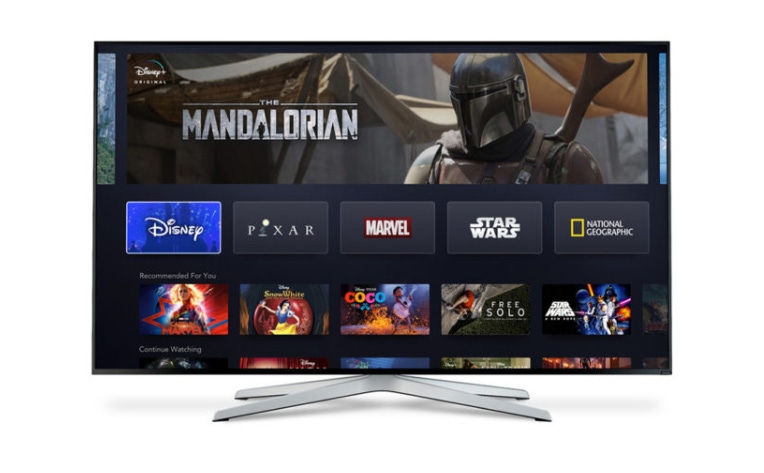Disney’s streaming service is off to a flier as the team boasts of 28.6 million paid subscribers during the latest earnings call. Could this be the genuine Netflix challenger the industry has been promising?
February 5, 2020

Disney’s streaming service is off to a flier as the team boasts of 28.6 million paid subscribers during the latest earnings call. Could this be the genuine Netflix challenger the industry has been promising?
Amazon Prime, HBO, YouTube and countless others have promised to lodge a challenge to the market dominance of Netflix, but few can say they come close. Netflix is still by far and away the leader in the market, but the early signs from the first three months of Disney+ suggest it could be the most likely contender to challenge for the title.
“While this seems to be a good start, it is still early days,” said Paolo Pescatore, founder of PP Foresight and Telecoms.com Podcast number one fanboy.
“The service is starting from scratch. Flagship programming has helped drive awareness and subscriber uptake. Disney will certainly be able to maintain this in the short to medium term, but it still has a long way to go before it is a true challenger to Netflix which is the global paid streaming service leader.”
One takeaway from this early success is that Disney seems to have priced the subscription correctly. The numbers speak for themselves, though the team believes the service will break even between 60-90 million subscribers. This might not account for additional marketing activities or increased spend on original, localised content, but it is a useful milestone to bear in mind.
Interestingly enough, the team expects the immediate gains to be in the international markets.
“In the near-term, we expect subscriber growth to come primarily from outside the US, with the next meaningful phase of domestic subscriber growth likely to coincide with the release later this calendar year of highly anticipated original content, including episodic series from Marvel and Season 2 of The Mandalorian,” said CFO Christine McCarthy during the Walt Disney Company first quarter earnings call.
While this is the opposite from the way in which Netflix produced success in the early years, it does make sense. Netflix is an incredibly popular brand in the US, entrenched in the lives of the consumers already. Netflix is currently focusing on demonstrating the value of the service to international audiences.
This is where Disney might be able to experience more success in the short-term. In terms of validating the value of the brand, Disney perhaps has an advantage over Netflix in some international markets. Disney is one of the most internationally recognised brands after all and it is a simpler task to acquire first-time customers as opposed to wrestling them away from the iron-like grip of Netflix.
After launching in the US last year, the team hoovered up more than 1 million paying subscribers in the first day. Since then the service has been launched in Canada, the Netherlands, Australia, New Zealand and Puerto Rico. Disney+ will make its debut in various European markets over the next few months.
The international markets, aside from a couple, are not as enthusiastic for paid streaming services as the US, so there will be a lot of marketing to demonstrate the value of the proposition. As CEO Bob Igor has pointed out, Netflix has begun seeding these markets with the value of streaming, but it will not be as easy to pry open wallets as it will be in the US.
While the Disney brand certainly holds credibility in the eyes of the international consumer, partnerships will play a vital role in securing subscriptions. The tie-up with Verizon is working well in the US according to the management team (20% of subscriptions are linked to this partnership) and connecting with Canal Plus in France should also be viewed as a positive. In the UK, rumours have been circulating surrounding a partnership between Disney and Sky, which would be a significant win for both parties.
For Disney, bundling the service with the most successful paid TV brand in the country and a prominent ISP makes sense. It is a direct link to the consumer, through an established brand which already has a billing relationship. For Sky, if it is able to embed the service in its interface (as it has done with Netflix), the proposition looks attractive as an aggregator to the consumer, building on its reputation for providing a high-quality content experience.
India is a market which is also on the horizon, with the team launching the service through its Hotstar service on March 29. This is a massive market for any content business, thanks to a significant population and a huge appetite for video content. Disney already has existing operations and a link to the consumer in India, so this could turn out to be a very profitable market, one which few US companies have had genuine success in.
These partnerships will be key to success, key to prying open the wallet of cash-conscious consumers and key to eroding the influence of Netflix on the subscription streaming market. It is certainly early days for the Disney streaming brand, but all indicators are green right now.
About the Author(s)
You May Also Like








.png?width=300&auto=webp&quality=80&disable=upscale)


_1.jpg?width=300&auto=webp&quality=80&disable=upscale)


.png?width=800&auto=webp&quality=80&disable=upscale)